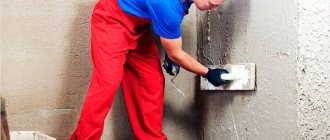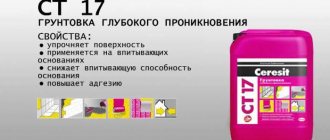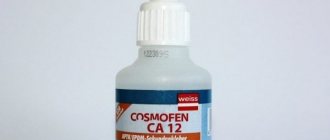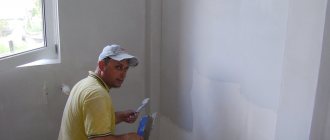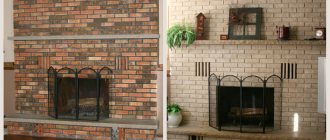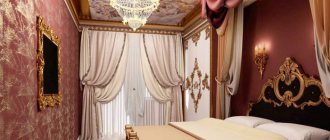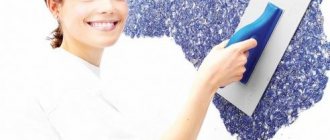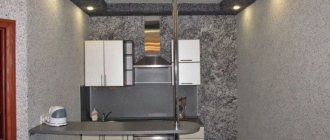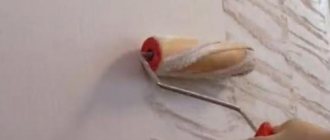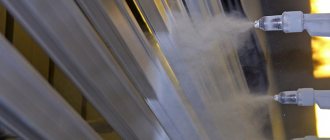What is liquid wall insulation
Today there are a lot of manufacturers who specialize in the production of liquid insulation.
Using this material you can solve a number of problems, including:
- Correct exchange of thermal energy, thanks to which the house can be found in time in winter and not overheat during the heat.
- The structure receives reliable protection from moisture.
- There is no formation of mold and fungi.
- The house is protected from external corrosion.
- Liquid heat insulator prevents condensation from forming in the corners of the house.
- The material can reduce heating costs in winter.
The consistency of the building material resembles thick paint. Its color is white, but to obtain a boring shade, you can add various colors to the composition. Liquid insulation for walls is a modern solution, thanks to which you can get excellent results directly in retaining heat and giving the building an attractive appearance. In addition, there is no need to additionally select disc dowels for attaching the insulation.
The photo shows liquid thermal insulation for walls from the inside
These insulation materials for the interior walls of a house have high quality characteristics, and the presence of a paste-like structure allows you to create high-quality protection for the walls. Thanks to its liquid consistency, the insulation can be evenly and quickly distributed over the surface and poured into hard-to-reach places.
Advantages and disadvantages
Each material has its own. However, based on consumer reviews, the main advantages of liquid insulation can be identified:
- Use for surfaces of different configurations.
- Liquid thermal insulation for walls from the inside will not take up much useful space.
- Minimum thermal conductivity due to the partially porous structure.
- Excellent resistance to external factors.
- Fire resistance.
The downside is that some liquids require special equipment to apply. It is expensive and not everyone knows how to handle it. This means that it is better to hire qualified workers to perfectly apply liquid insulation.
Features of insulation
To independently insulate a house with foam, you need a protective suit. Foam is usually sprayed from a can onto the entire surface of the facade; it fills the voids between walls, rafters, and beams.
There are many advantages to this type of wall insulation with foam in the air gap. The main ones include:
- vapor permeability;
- fire resistance;
- ability to increase in volume;
- resistance to various types of mechanical stress;
- the upper temperature limit remains within +80 degrees.
Foam is often used to seal cracks that remain after installing plastic windows. Due to this, the thermal insulation in the apartment also increases. It is convenient to use a pneumatic gun for insulating not only windows and external walls, but also foundations, loggias and balconies, and pipes.
After treatment with foam insulation for walls, the facade turns out perfect - without visible joints or seams. One cylinder contains on average 600-700 ml of the composition, which is enough to treat a square meter with a layer up to eight centimeters thick. Operating such a gun is very simple: first, a full cylinder is inserted into it, then you need to point it at the surface to be treated and pull the trigger. On average, the applied composition hardens within 24 hours.
Features of liquid penoizol
Another contender for wall insulation is liquid penoizol. This material is capable of surpassing mineral wool and expanded polystyrene in its technical characteristics. The basis of the raw material is foamed and hardened urea resin.
Penoizol is included in the average price range on the building materials market, which is why it is so popular among wall insulation specialists. The use of raw materials has been echoed since the 30s of the last century, but then foam insulation insulation was not in demand due to its high cost. It is also possible to produce the material on the construction site.
Penoizol for wall insulation
This raw material is often used as a frame filler between the inner and outer surfaces of the wall. But thanks to its good performance, penoizol can be used for placement on a vertical wall.
Several main characteristics of this material:
- does not increase in volume;
- It is a soufflé-like mass, similar to foam;
- used for insulating walls and floors;
- lasts about 50 years;
- low water absorption.
Penoizol is used in external walls and partitions of houses made of wood and reinforced concrete; in buildings that are subject to repeated dismantling, as well as in roofing panels.
The cost of liquid penoizol depends on the brand. For example, in advertisements you can often find direct prices for pouring material - from 1,500 rubles per 1 cubic meter. meter. At the same time, some manufacturers offer components for the independent production of penoizol - VPSG resin, ABSPA and orthophosphoric acid.
Advantages and disadvantages
Before you start insulating your home, you need to weigh the pros and cons. Of course, many are interested in what benefits will come from this method of insulation. These include:
- fast speed of insulation, even if a large surface is processed;
- foam is not subject to biological influences, mold or mildew is unlikely to appear on the wall;
- low-flammability material: it can only melt at temperatures above 80 degrees;
- there is no need to first attach the frame to the facade - this saves effort, time, and money;
- a monolithic surface is obtained without seams into which cold air could penetrate;
- When insulating pipes or other metal elements, a sufficiently dense layer is created, through which moisture will not seep through and corrosion will not appear.
But, like any other insulation method, it has its drawbacks. You should know about them in a timely manner:
- should not be exposed to direct rays;
- inability to interact frequently with water;
- cost of material: to insulate large areas you will need to buy or rent special equipment;
- insufficient level of vapor permeability, artificial ventilation will have to be installed inside;
- You cannot perform the application procedure without a tarpaulin suit, a respiratory mask with goggles and gloves. Of course, all this is unlikely to be found at home, and this is also an extra waste of money.
People have long begun to insulate their homes with foam, but the ideal means of insulation has not yet been invented. Of course, the effectiveness of this method cannot be disputed. The main thing is to buy high quality materials. If you have equipment for installation, the process will not take much physical effort and time.
After applying the foam composition and after it has completely dried, craftsmen advise treating the surface of the facade with a special coating, which can be purchased at any hardware store. This is required first of all to protect human health, and only then - to protect the insulation itself.
Vapor barrier and waterproofing
When insulating, you should pay attention to vapor barrier, otherwise the surface will very quickly become unusable. The most commonly used liquid rubber is liquid mastic . This is an excellent vapor barrier that does not allow moisture to pass through.
Rubber should be applied in an even layer; its significant advantage is that seams do not form after use. Rubber must be applied by spray, directly on top of the thermal insulation . The layer should not be more than a millimeter.
Vapor barrier of walls
Waterproofing protects various building structures from moisture penetration. It is easy to apply, does not require special qualifications from workers, and does not form seams.
The choice of liquid insulation remains with the owner of the house or apartment. But, in any case, when buying a material you like, you need to carefully study the characteristics (technical as well as operational) and instructions for applying the product to the selected surface.
Types of liquid insulation for facade walls
Taking into account the application technology, composition and operational characteristics, all types of liquid insulation can be divided into two types: ultra-thin and foam. Ultra-thin (warm paints) are the newest development of building materials technologists, universally applicable. Ultra-thin insulation materials significantly reduce the cost of work on insulating facade walls, reduce work time and improve quality. But they also have negative sides, we will talk about them throughout the article.
Types of liquid thermal insulation and popular manufacturers
Liquid thermal insulation from the following companies is considered to be the most popular on the domestic market:
- Akterm;
- Corundum;
- Astratek;
- Thermomet;
- Isollat;
- Teplosil;
- Armor;
- Lic Ceramic.
We will consider the types of liquid thermal insulation based on the latest manufacturer.
- Standard . Standard thermal insulation is applied exclusively in the spring and summer months. Operating temperature range -58 to +500 Fahrenheit.
- Ultra . This thermal insulation material is significantly different from the previous version. It has improved thermal conductivity, which is 0.0012 . The specific gravity of thermal insulation decreased several times, as a result, this affected the reduction of consumables during coating application. This mixture does not need to be stirred from time to time in liquid form, all because the microspheres are evenly distributed here.
- Thermo . It is recommended to be used when repair work is carried out in winter or late autumn. Designed exclusively for metal surfaces . The application temperature for this type of liquid thermal insulation is from -4 to +122 Fahrenheit. And the operating temperature is from -58 to + 752 Fahrenheit.
Liquid foam
This type of insulation includes almost all foam materials based on polymer resins. The quality of the final product, including its environmental friendliness, largely depends on them. There are raw materials whose use is not permissible for residential premises due to the high toxicity of the polymer and its long-term emissions. At the same time, such materials are quite suitable for insulating technical structures or isolated building elements (if there is confidence in their insulation and the conscientiousness of the working specialists).
At the moment, such types of liquid foam as polyurethane foam, penoizol, as well as a number of products in compact cylinders are common.
Polyurethane foam (PPU)
Viscous heterochain polymers in a liquid state are used as the main component of this insulation. During chemical reactions, urethanes foam, which leads to their increase in volume by more than 50 times.
In its frozen state, polyurethane foam resembles ordinary polyurethane foam, the main difference in the structure is less porosity.
Mainly used for:
- Insulation of walls of frame buildings;
- Roofing structures;
- House facades;
- Thermal insulation of basements and lower floors.
To apply polyurethane foam, you need a special unit that first mixes and foams the insulation components, and then delivers the finished mixture under pressure to the surface to be treated.
Final polymerization occurs within 24 hours, after which the finishing can be installed. Polyurethane foam is suitable for treating surfaces made of brick, concrete, wood, metal, cinder blocks and gas silicate blocks.
The average cost of work including material is 1000-1500 rubles per m2 , with a layer thickness of 50 mm.
Penoizol
A budget analogue of polyurethane foam insulation, since it is based on relatively cheap, but more toxic urea-formaldehyde resin. The structure of this insulation is very similar to ordinary foam plastic, but its use is more preferable due to the absence of cold gaps in the insulating layer, characteristic of sheet and roll materials.
The density of penoizol, even in a liquid state, is noticeably lower than its urethane analogues, which does not allow its use in loaded structures. Otherwise, the scope of application is similar to polyurethane foam. Thermal insulation qualities are also not exceptional and are comparable to mineral wool, and two times less than that of the polyurethane foam described above.
Apply under pressure after pre-mixing the components and foaming. Increases in volume by no more than 30 times relative to the original mixture.
Roof insulation with foam insulation
Work together with the material costs approximately 2000 rubles per 1 cubic meter .
"Polinor"
This is a liquid insulation based on polyurethanes. A common form of release is small cylinders, similar in appearance to those for polyurethane foam. Using one cylinder you can insulate about 1 m2 of surface with a layer thickness of 6-7 cm.
The strength and thermal insulation qualities are similar to polyurethane foam, but unlike it, “Polinor” is more suitable for household use, since it does not require special equipment for application. The relatively high cost (about 500 rubles per cylinder ) makes its use inappropriate over large areas.
The insulation is applied by spraying, which allows it to be used on almost any surface, for example, for thermal insulation of pipelines located outdoors.
As for filling voids in the walls, this procedure cannot be completed due to insufficient pressure in the cylinder.
"Polinor" has the following technical characteristics:
- Thermal conductivity – 0.025 W/(m*K);
- Moisture absorption coefficient – no more than 0.03;
- No toxicity, non-flammable;
- Solid density – not less than 28 kg per m3;
- Retains all operational properties for 50 years;
- The operating temperature should not exceed +121°C;
In addition, the mixture is quite chemically stable and does not interact with most reagents common in everyday life. Chloroform, dichloroethane, and high concentration hydrochloric acid have a negative effect (promote swelling) on Polinor. Nitric and sulfuric acids react with polyurethane, thus destroying the insulating mixture as a whole.
Thermal insulation properties of liquid and traditional insulation materials
Below are the thermal conductivity coefficients for the most common thermal insulation materials used for domestic and industrial needs:
- Mineral wool – 0.06 – 0.07 W/(m*K) (depending on density);
- Sheet foam 0.037-0.05 W/(m*K) (it must be taken into account that there will be additional heat loss at the joints of the sheets);
- Penoizol – 0.06 W/(m*K);
- Expanded polystyrene – 0.03 W/(m*K);
- Polynor – 0.025 W/(m*K);
- Thermal paint – from 0.0012 to 0.025 W/(m*K) (Depending on the brand and purpose of the specific product).
It should be remembered that during actual operation the thermal conductivity parameters will not differ for the better.
Using foam for wall insulation
Foam is widely used for wall insulation - both on the side of the room and on the side of the building facade. A gun attachment or specialized equipment can be used for application. This type of material holds well on both horizontal and vertical, as well as inclined planes.
The main features of thermal insulation of walls using this method include:
- Increasing the thickness of the walls. Thus, they will be able to better resist negative external influences.
- Extended operating temperature range. It is up to +80 degrees Celsius.
- Vapor permeability.
- High degree of resistance to mechanical damage. Impacts do not cause deformation or destruction of the insulation.
- The heat insulator belongs to the non-flammable group.
Foam can be used to insulate the following construction projects:
- door and window openings;
- façade of buildings;
- foundations;
- balconies, loggias, attics;
- engineering communications (pipelines);
- attics.
The applied material does not form joints or seams. The curing time for the foam can vary from 24 to 72 hours, depending on how many layers you apply.
Internal insulation
Thermal insulation of a room from the inside is permitted only if there is no other possibility. For example, if you live on the top floor of an apartment building. This instruction is contained in SNiP 23-101-2004. When carrying out such work, it is extremely important to take care of reliable waterproofing. Otherwise, you will get a shift in the dew point, which will lead to dampness and mold growth.
Over time, this nuisance can destroy or weaken the supporting structure.
External insulation
But external insulation is considered the most effective and safe solution. The most important thing is that the dew point remains unchanged, which allows you to keep the walls of the room dry and warm.
Wall construction
The wall pie should consist of:
- Thermal insulation;
- Cement board;
- Lathing;
- Brusa;
- Hydro-wind protection;
- Plasterboard sheet;
- Membrane film.
Roofing pie , despite its apparent simplicity, must be made in accordance with certain rules:
- The climatic zone and purpose of the house should be taken into account when calculating the thickness of the walls;
- To choose insulation you need to pay attention to good sound and heat insulation , reasonable price;
- If the purchased thermal insulation does not have special protection against getting wet and other negative influences, it is rational to use a special film;
- It is extremely necessary to apply insulation correctly to avoid the appearance of cold zones where heat can leak in the future;
- The construction of the façade is carried out taking into account the requirements for the materials used.
Wall construction
What is the best way to insulate with foam - from the outside or from the inside?
Thermal insulation with foam has several nuances. It is impossible to take and close all the holes, since then the level of humidity in the room will increase, which will negatively affect the insulation process. For example, the walls will begin to collect condensation and become wet over time, which will certainly affect the performance of the house.
The method of insulation from the inside or outside of the house is largely dependent on what material the walls are made of. If it is a brick, then it is recommended to insulate the structure from the outside using a sandwich scheme, that is, you need to put a layer of insulation between two bricks. Since it has insulating properties, it provides a space with double the effect and warms the rooms in the house with minimal need for additional heating.
In the case of concrete walls, craftsmen use insulation under the drywall during repairs. However, there is always the possibility that improper filling of voids with foam will lead to the formation of a cold bridge. Due to the loose fit of the material, cold street air will penetrate into the house.
Before you decide whether to insulate your home from the outside or inside, you need to determine the dew point. The closer it is to the parameters of the actual humidity temperature in the rooms, the higher the risk that internal insulation will provoke the appearance of wet spots on the walls. This point is calculated by comparing atmospheric pressure, relative and actual temperature conditions.
Thermal paint
This is a relatively new material that appeared on our market no more than a decade ago. It is used as insulation for walls inside and outside buildings.
Compound
The insulating components of thermal paint are particles of glass ceramics, aluminosilicates, titanium dioxide.
In appearance, paint thermal insulation is practically no different from ordinary acrylic paint - it has a similar structure and even smell. However, thermal paints, unlike acrylic paints, are a high-tech product and have a rather complex composition.
In scientific terminology, this is not just paint, but a liquid suspension with a heat-preserving effect. It consists of the following components:
- Small glass-ceramic particles having a spherical shape. Their diameter ranges from 0.05 to 0.1 mm.
- Spherical microfillers made of aluminum silicates are the same size as glass-ceramic ones. A special feature of aluminosilicate spheres is the absence of air in them: the vacuum inside makes them an excellent heat insulator.
- Titanium dioxide – having a porous structure, it is very light in weight. Prevents the transfer of heat from the warm walls of the building to the cold outside air.
- Latex. Gives thermal paint resistance to solar radiation, compensating for thermal expansion/contraction. This prevents cracking and peeling of the painted layer and increases the service life of the liquid thermal insulation. This allows the suspension to be used for treating exterior walls: facades, basements, as well as gables of insulated attics, etc.
- Acrylic. It plays the role of the basis of the entire heat-insulating mixture, hence the similarity of the liquid insulation with conventional acrylic paints. Acrylic gives the composition excellent adhesion to almost any treated surface.
Specifications
Paint microspheres are filled with air, forming a kind of air cushion.
According to manufacturers, paint-based liquid insulation materials have unique thermal insulation properties. Thus, according to technical tests, a layer of thermal paint of 1.1 mm can effectively replace a layer of mineral wool with a thickness of 50 mm.
This brilliant indicator is achieved due to the presence of a large number of vacuum-filled microspheres inside the thermal layer. This significantly reduces heat loss from inside the building due to convection. The brilliant color created by glass ceramics, aluminum and titanium derivatives provides additional protection by reflecting infrared radiation.
In general, the paint-based heat-insulating coating works like a reflective coating on a thermos. The consumption of the heat-insulating suspension is 1 liter per 2 sq.m., when applied with a thickness of 0.5 mm. It is applied in several layers until a thickness of 1 - 2 mm is achieved.
Comparative characteristics of liquid paint insulation, mineral wool and polystyrene foam.
| Parameter | Thermal paint | Minvata | Styrofoam |
| Thermal conductivity (W per square meter per second) | 0,001 | 0,045 | 0,05 |
| Layer thickness required to achieve the same thermal protection performance | 1 – 1.2 mm | Up to 60 mm | 45 mm |
| Cost of fastening elements for installation of 10 sq.m. insulation | 0 rub. | OK. 600 rub. | OK. 500 rub. |
| The cost of installation work by a team of professionals per 1 sq.m. | 150 rub. | 650 rub. | 550 rub. |
| Cost of 1 sq.m. coatings | 800 rub. | 1300 rub. | 2500 rub. |
As can be seen from the table, thermal paint has truly unique properties, which are far from even achieved by polystyrene foam and mineral wool, which were the most effective insulation materials.
However, as practice shows, the characteristics declared by manufacturers do not correspond to reality. In reality, its properties are much worse than described in advertising brochures.
The use of the coating will increase the heat by 1.5 - 2 degrees.
Regardless of whether the walls are insulated from the outside or from the inside, it will not be possible to achieve the indicator declared by the manufacturer (1 mm layer of thermal paint = 50 mm layer of mineral wool). According to the instructions for use, it is enough to apply a heat-saving suspension to the surface with a roller or brush to dramatically warm up the interior.
As the practice of using such materials shows, painting the brick walls of a building with them can increase the temperature in the premises in winter by 1.5 - 2 degrees. That is, there is still some effect from the warm paint, but it is, of course, far from the notorious 1 mm = 50 mm.
To achieve a similar result, according to basic calculations, it will be necessary to cover the perimeter of the house with 12 - 15 layers of heat-saving suspension. And this will be simply unrealistically expensive, given the high cost of such compounds.
Advantages of warm paints
The mixture has a beautiful iridescent metallic sheen.
But despite the controversial issue of the effectiveness of heat-saving paint, it still has a number of advantages. First of all, this is the aesthetic side. As experienced finishers advise, if you have decided to paint your house, then it is better to use thermal suspension for these purposes, of course, if its cost fits into your estimate.
On the one hand, there is an excellent decorative effect, which is provided by a coating with an iridescent metallic sheen. On the other hand, there is at least some heat-saving effect, which conventional paint and varnish compositions lack.
Thirdly, thermal paint has anti-corrosion and antiseptic properties, so treating the internal or external surfaces of a building, as well as communication pipes and ventilation ducts with similar mixtures, will prevent the appearance of fungus, mold and corrosion on them.
A significant advantage is the water-repellent quality of the paint, which allows you to additionally create a layer of waterproofing for internal or external wall surfaces. The convenience of using thermal suspensions for insulating communication pipes in hard-to-reach places is undeniable. The ease of application makes this method of thermal insulation the most successful.
Choosing the right thermal paint
The thicker the paint, the better it will protect against heat loss.
Since thermal paint has a considerable price, you should be able to choose the right quality product. To do this, you should know a few nuances.
- The lower the density of the coloring composition, the higher its thermal insulation properties. Typically, a 10-liter bucket of suspension should weigh no more than 6.5 kg. Otherwise, there is a high probability that the expensive composition was diluted with simple acrylic paint, worsening its technical properties.
- Lift the bucket and look through it at the light. Lightweight microsphere fillers should rise to the top, creating a layer of metallic color at the top. The thicker this layer, the higher the quality of the suspension.
- If, after stirring high-quality paint, you stretch a drop of it between your fingers, you can feel the presence of a large number of microspheres: the surface will not be smooth, but rough.
Application method
Cover the walls with several layers of paint.
Insulating walls with liquid insulation is not difficult.
It is produced in several stages and is completely similar to the work of painting surfaces with conventional paints and varnishes.
When purchasing a thermal composition, it should be taken into account that the surface will have to be treated more than once. Depending on the climate zone in which the home is located, it may be necessary to apply from 2 to 5 layers of paint.
The whole process looks like this step by step:
- You should measure the area of the surface to be painted and purchase the required amount of thermal protective suspension.
- Preparing the surface for applying paint - removing dust and dirt, filling cracks and seams, treating with a primer composition.
- Before use, the paint should be thoroughly stirred with a mixer attachment to evenly distribute the spherical filler granules throughout the entire volume.
- Apply thermal paint to the surface using a spray gun or roller. We paint the seams and corners with a paint brush.
- After the first layer has dried, apply the second layer, etc. For more information about thermal compositions, watch this video:
Until it dries completely, that is, at least a day, the painted wall should not be exposed to heavy rain. It can wash out light micro-grain fillers from paint, which will turn expensive thermal insulation into ordinary acrylic paint.
Advantages and disadvantages
Foam, which is used for thermal insulation, is distinguished by its features, which distinguish it from similar materials:
- Once applied, the material easily penetrates even very small potholes and crevices, sealing them securely.
- High levels of heat insulation in the house.
- The treated surface has no joints or seams.
- The light weight of the material allows you not to create additional load on walls and other load-bearing structural elements.
- Cured foam is absolutely safe for human health and the environment.
- In an insulated room, noise insulation performance increases significantly.
- The material does not come into contact with metal elements and prevents them from corroding.
The only significant disadvantages include the significant price of both the material itself and the professional equipment for its application.
Tips and recommendations when choosing liquid thermal insulation for walls
First, decide where to apply the heat paint. Most often, the manufacturer labels the jar with the product. Look carefully at what surface you will apply this product to.
Also take a closer look at the contents of the jar. It must be uniform, without plaques or any inclusions. It is better if the color is white, but beige and gray shades are possible.
Do not ignore the density of the product. Low values will give greater heat transfer. Also find out the service life and interaction with various environmental indicators.
Not every liquid thermal insulation has an easy application method. The tool should be easy to use. Give preference to trusted companies.
Video - Liquid thermal insulation Armor: do-it-yourself insulation of a balcony, loggia, walls, ceiling, floor
Technology of insulation of facade walls with liquid foam plastic
To insulate the facade of a house with liquid polystyrene, in addition to a special unit, it is necessary to prepare an electric hammer drill and drills with Pobedit tips for the diameter of the filler tube. In addition, you should prepare wooden pegs in advance to temporarily plug the holes while foaming the space between the walls.
After all the tools and materials are prepared, the procedure will be as follows:
- on the wall, in a checkerboard pattern, drill holes in the seams between the bricks in increments of 1 meter;
- start filling the space from the lowest hole (air pressure should not exceed 5 atmospheres, otherwise cracks may appear on the lining).
It is extremely important to work with an assistant: while one turns the supply of liquid foam on and off, the second installs the pipe into the holes and controls the filling of the space with insulation. As soon as foam appears in a nearby hole, the assistant closes it with a wooden wedge, and after the supply of foam has been stopped, inserts the pipe into the adjacent hole.
You always need to work from the bottom up. If foam does not appear in the adjacent hole for a long time, you need to reduce the distance between them or slightly increase the pressure in the system.
Attention: If the brick wall is not laid well enough, then turn off the device when foam appears from the cracks in the masonry mortar. In this case, control and filler holes in these facades need to be drilled closer to each other.
Once the entire perimeter of the facade has been processed, the insulation work can be considered complete. The next step is to remove any remaining foam. If the work was carried out on walls prepared for subsequent finishing, then large pieces of frozen foam can simply be broken off.
If the wall is already finished with decorative bricks, then traces of the insulation must be removed with a clean damp cloth, and then clean the filler holes a little and seal them with cement-sand mortar to match the color of the joints.
The process of insulating walls with liquid foam is described in detail in the following videos:
Foamed polymers
Another liquid thermal insulation is foamed polymers - liquid foam, polyurethane, etc.
Advantages and disadvantages of foam insulation
The foam fits tightly to all protrusions of the wall.
Unlike solid insulation boards, liquid polymers provide an increased level of thermal insulation. The fact is that when installing sheets of the same foam plastic, it is very difficult to achieve their tight fit to the wall surface. In any case, over time, a gap forms between them, which significantly reduces the effectiveness of thermal protection.
When liquid foam is applied to the surface being treated, it adheres tightly to it without forming any gaps. Due to the excellent adhesion of foam compounds, they are firmly held on any surface - wooden and brick walls, metal pipes and concrete floor slabs.
Internal walls insulated with foam can be covered with finishing material
In addition, for uniform and durable application of foam there is no need to level, putty or otherwise prepare the walls. If foam insulation is applied to the façade parts of a building, after hardening it can be subjected to further decorative processing. Trim off excess foam and foam, and then treat it with a leveling putty compound. The service life of such thermal insulation can be about 50 – 70 years.
Among the disadvantages of these thermal insulation materials, it is worth pointing out their low environmental friendliness. When heated, polymers begin to release volatile chemicals, and when burned, they begin to release large amounts of acrid smoke.
Air and steam will no longer be able to pass through foam-treated surfaces.
The fire resistance of foam insulation is simply zero. Not only can it not create reliable protection against fire, but it itself actively supports combustion, contributing to the spread of fire.
Another disadvantage is that surfaces treated with foam no longer allow air to pass through them. As a result, the natural gas and steam exchange indoors is disrupted. To restore it, it is necessary to install an efficient ventilation system.
The only exception here is penoizol - it does not support combustion under normal conditions and can serve as fire protection.
Compound
Foam insulation is produced using a number of complex components. They include:
- Urea-formaldehyde resin.
- Orthophosphoric acid.
- Foaming chemical components.
- Water.
Due to the fact that toxic substances are used as components, when working on spraying foam insulation, you should use protective clothing, including respirators, goggles and gloves.
Enhancing sound insulation with foam
Foam insulation has a soundproofing effect. Its severity depends on:
- layer thickness;
- elasticity indicator;
- tightness of the resulting layer.
It is important to consider that most balloon varieties of foam will be inferior to sprayed material in terms of sound insulation quality. The only exception is the “MAXFORTE SoundFLEX” brand, whose performance is as close as possible to professional ones.
Thermal insulation paint
Insulating foam is not the only thermal insulation product that has a liquid consistency. Along with it, liquid ceramic paint is used. Compared to foam, this paint has less pronounced thermal insulation qualities. At the same time, the latter has better waterproofing properties.
It is recommended to apply paint only at the junctions of structural elements of a residential building, for example, between the roof and walls. Some people use this material to insulate rooms from the inside, but this is a big mistake. On the one hand, to achieve the desired thermal insulation effect, you will need at least 10 layers of paint. On the other hand, the thermal insulation layer is never placed on the inside of the walls, since this will lead to the formation of condensation in the building due to an incorrectly calculated dew point.
Technology of applying liquid thermal insulation
Liquid insulation is quite easy to work with, so you can handle the procedure yourself, without the involvement of specialists. To do this, it is recommended to follow some recommendations:
- It is better to first eliminate wall unevenness using a grinder with a brush attachment;
- metal surfaces are pre-cleaned of dust and degreased;
- Gloss is removed from glossy metal and treated with a primer;
- the composition is prepared immediately before use;
- liquid insulation is applied in layers, each of them must dry well and harden.
Each type of thermal insulation has its own rules, which are familiarized with before insulation measures.
Tools and materials
Due to the fact that liquid thermal insulation is available in different types, the equipment for its application and related tools and materials may also differ. To work you will need:
- spray gun for applying heat paint;
- electro-pneumatic low or high pressure installation;
- roller, brush;
- container for the material, if it is not in disposable cylinders;
- chisel, hammer;
- protective clothing, respirator, goggles.
For liquid thermal insulation you will need a spray gun.
Usually, on the packaging with the composition, manufacturers indicate in what way and with what tools it should be applied.
Preparatory activities
Preparation for applying liquid insulation begins with cleaning the walls. Contaminants, dust, and serious bulges that will interfere with normal adhesion of the material to the wall are removed from the surface. Cracks and crevices larger than 5 mm must be covered with cement mortar.
Next, you need to make a wooden or metal frame into which the insulation will be poured. The sheathing posts must be placed strictly vertically and have a single plane.
Immediately before use, mix the insulating mass. To do this, calculate the required amount of material and dilute it with 5% distilled water. Mix the thermal insulation using a construction mixer or drill. The maximum number of revolutions should be in the range of 150-200 rpm. If you exceed the speed, the likelihood of violating the integrity of the structure of the liquid mass increases.
Work on insulating external walls is carried out in dry weather. If it rains, it is better to postpone the procedure until a more suitable time. Optimal conditions are a sunny but not hot day, the surface temperature should not exceed 30 degrees Celsius.
Application steps and instructions
Depending on the type of thermal insulation, use a brush or spray gun. The material is applied in thin layers. Each of them dries within 24 hours, provided that the temperature of the surface being treated is not lower than 70 degrees and the air humidity is not more than 80%.
It is best to do three layers. When using a spray gun, the pressure should not exceed 80 bar. If a roller is used, the heat paint is poured into a low container. The tool is dipped into the composition and wait until the paint completely saturates the fabric. After this, the wall is treated with uniform movements, with movements from top to bottom.
Practical tips for applying thermal paint
Following the simple advice of experienced specialists related to the application of insulation in liquid form will allow you to use less material, reduce work time and ultimately obtain a high-quality coating.
- If the coating is applied to a perfectly leveled surface, you can save on the amount of insulation required without losing quality. Sharp protrusions are usually covered with less paint than smooth walls. It is these zones that are most prone to the formation of cold bridges, the formation of which is associated with negative consequences. Before you begin applying liquid polymer insulation, the surfaces must be carefully leveled using any of the known methods. All cracks, flaws, and irregularities must be eliminated. Otherwise, during the process of polymerization and drying of the insulation, cracks will appear in these problem areas.
- The material itself must be prepared for application immediately before starting work. The mixture must be stirred every half hour, and also ensure that the paint does not separate due to the different densities of its components.
- If stirring is done with an electric drill with a mixer attachment, it is important to monitor the maximum number of revolutions of the chuck. It should not exceed two hundred revolutions per minute. If this recommendation is not followed, all efforts to insulate the room can be reduced to zero, since at significant speeds the microgranules of the paint are damaged, due to which it almost completely loses its valuable insulation properties
Warm paints
They contain ready-made additives that do not require pre-foaming.
"Corundum"
The Russian brand that produces this insulation provides a guarantee for its products for up to 15 years. The material has a uniform viscous texture with high adhesion to various surfaces. Corundum is applied with a spatula or paint brush. It can also be sprayed, but must first be diluted with water.
The manufacturer offers several variations of thermal insulation:
- "Facade";
- "Winter";
- "Anticor";
- "Fire protection";
- "Lotus";
- "Classic";
- "Waterproofing";
- "Sanitary";
- "Foundation".
"Armor"
This thermal insulation is produced by a Vologda company that has copyrights to the insulation composition. The paint has a fairly thick consistency, allowing it to adhere well to any surface. It has water-repellent properties and can also be used as a waterproofing coating. Like the previous mixture, “Bronya” is available in several versions:
- "Classic";
- "Light";
- "Standard";
- "Universal";
- "Facade";
- "Metal";
- "Wall";
- "Fire protection";
- "Volcano";
- "North";
- "Winter";
- "Anticor".
"Akterm"
The country of origin of this thermal insulator is Russia. The company produces paints intended for two types of work: insulation and waterproofing. The Akterm product line is represented by 13 formulations with different technical characteristics:
- "Concrete";
- "Metal";
- "Anticor";
- "Facade";
- "Standard";
- "North";
- "Volcano";
- "Akterm - NG paint";
- "Anti-condensation";
- "Fire protection";
- "Hydrophobizer";
- "Zinc";
- "Plast".
When using Akterm thermal paints for walls or facades, you can add different colors to them.
"Astratek"
Another Russian brand that ranks first among manufacturers of modern liquid insulation. The paint has a uniform texture, the consistency resembles a suspension. This liquefied structure allows it to be applied not only with a paint brush, but also with a sprayer. The manufacturer produces several variations of formulations:
- "Facade";
- "Metal";
- "Universal";
- "Anti-condensation".
Warm paints
Unlike foaming polymers, thermal paints contain ready-made additives that provide thermal insulation. The most common are ceramic microspheres, fiberglass particles, perlite fillers or foam glass. Acrylic dispersion is used as a binder; water-based mixtures are also common.
Corundum
Multicomponent heat insulator on a polyacrylic base. Ceramic microspheres of different densities are used as a filler in its composition, which allows you to create a thin porous coating.
This is a white suspension, similar in consistency to regular facade paint. Once hardened, corundum forms a durable coating that is resistant to cracking due to its ductility. This allows the mixture to be used as insulation in a fairly wide range:
- Thermal insulation of walls, window and door openings;
- Insulation of floor coverings and roofs;
- Pipelines for any purpose, as well as steam pipelines and air ducts in air conditioning systems;
- Refrigeration systems (thermal insulation of refrigerators, thermal boxes and trailers).
One common application is the insulation of cold water supply lines. A layer of thermal paint prevents the appearance of condensation and corrosion on metal pipes.
Depending on the surface being treated and the required degree of insulation, several types of insulation are available:
- Classic . A universal mixture to protect almost any surface. Retains all performance qualities over a wide temperature range (from -60° to + 200°C) for at least 15 years. A twenty-liter bucket costs about 8,000 rubles . This is enough to cover up to 40 m2 of surface with a layer of 2-3 mm.
- Antikor . As the name implies, this composition can be used to protect metal elements from corrosion, including those elements that already have rust (the main thing is to remove loose fragments). The mixture has high thermal insulation properties, and its cost does not exceed 450 rubles per liter.
- Winter . Unlike conventional mixtures, when applied, the ambient temperature should not be lower than +5°C, Corundum Winter insulation can be used even in cold weather (down to -10°). This is the most expensive product in the line (the cost exceeds 500 rubles).
- Facade . The priority use of this mixture is insulation of external surfaces made of brick, cinder block or concrete. The material is weather-resistant and quite vapor-permeable. Cost - about 400 rubles / liter.
Akterm
The Akterm range of mixtures includes more than 15 products, many of which are highly specialized and designed to solve specific problems.
Among the thermal insulation compositions, the most popular are the following:
- Standard . An effective material on a water-dispersed basis, used as a thermal insulation and waterproofing agent in industrial and domestic conditions. Price – 340 RUR/l.
- Vulcan . Used to insulate surfaces whose operating temperature reaches +500°C. Can be applied to metal and concrete (brick, cinder block, penoizol, etc.). Price – 450 RUR/l.
- Nord . An organic based mixture that can be applied at ambient temperatures from -35°C. Compatible with various surfaces, it is resistant to aggressive environments and has anti-corrosion properties. Price – 360 RUR/l.
- Facade . Weather-resistant insulation with high energy-saving parameters. It is used for thermal insulation of walls on the street side. Price – 340 RUR/l.
- Anti-condensation . A water-dispersed mixture to prevent the appearance of condensation and mold formations. Price – 340 RUR/l.
- Metal . Operating temperature can reach 190°C. Applied to metal surfaces, it protects against condensation, freezing and corrosion. Price – 350 RUR/l.
- Concrete. A product for indoor use, a millimeter layer of which has barrier properties (prevents heat leakage on one side and cold penetration on the other). Prevents the formation of mold and condensation. The finishing layer is strong enough that it can be decorated (wallpaper, paint). Price – 340 RUR/l.
Astratek
Liquid polymer insulation. Thanks to special additives and low-density fillers, it has good thermal insulation properties at a relatively affordable cost. Currently the range includes the following products:
- Station wagon. Standard mixture for indoor and outdoor use. Can be applied to metal, wood, concrete materials and even plastic. Cost – 415 rubles/l.
- Metal. Designed for thermal insulation of metal surfaces. Prevents corrosion and condensation. Operating temperature – up to 260°C. Cost – 445 rubles/l.
- Facade. The priority use of this mixture with high viscosity is outdoor vertical structures. Significantly reduces heat loss and can be used both for reconstruction and in new buildings. Cost – 430 rubles/l.
- NG. Non-flammable heat-resistant material for insulating fire-hazardous structures (class KM0). Applied to plastered or brick substrates, can be used indoors and outdoors. Operating temperature – from -60°C to +200°C. Cost 445 RUR/l.
- Station wagon. The prefix BC means all-season, which allows you to work with the mixture at temperatures from -30°C. Otherwise, the properties of the mixture are identical to the “Universal” brand. Cost 495 RUR/l.
- Acoustic decor. Decorative heat-insulating mixture that reduces the intensity of penetration of external noise. Price 445 RUR/l.
Application order
The sequence of work depends on which liquid insulation is selected.
If you decide to use penoizol or polyurethane foam, you need to purchase a disposable or reusable kit for spraying or pouring the mass.
Spraying involves working with open surfaces. The essence of this technology is that the foam is sprayed over the wall in a uniform layer 5-10 cm thick. Before this, the wall is cleaned and any remaining wallpaper or paint is removed. In increments of up to 50 cm, guides are attached using self-tapping screws - wooden slats or aluminum profiles.
Usually the guides are located vertically, strictly at right angles to the ceiling and floor, but sometimes horizontal strips are also installed. The space between them is filled with foam, while the guides themselves should protrude above the foam. They are needed in order to mount sheets of drywall on top of them when the insulation dries.
Filling method
The pouring method is more difficult to implement. It consists in filling voids with foam that cannot be treated by spraying due to difficult access. During pouring, liquid insulation is fed into the cavity, where, due to its elasticity, it is evenly distributed.
The pouring technology allows you to get rid of voids in already installed main walls, or after installing a plasterboard covering. In this case, one condition must be met: there must be access to the cavity, at least in the form of a small hole, where the nozzle of the unit for filling the mass can fit. Sometimes foam is poured into the mold immediately at production. This is how thermal insulation blocks are obtained, which can later be mounted inside the walls instead of spraying.
Corrosion protection
If you plan to insulate a metal pipeline, you must first paint it or protect it from corrosion in some other way. Manufacturers of penoizol and polyurethane foam never warn about this, but without proper protection, the pipe will rot and crumble. Then you will have to completely remove the insulation to gain access to it for repairs.
Foam for insulation is supplied to the gun for pouring or spraying through hoses from a container with raw materials. In the case of polyurethane foam, these are two tanks: one contains polyisocyanate, and the other contains polyol. It is important that there is no air in the containers and hoses, as it will interfere with the reaction of the substances.
Description of insulation
To increase the energy efficiency of buildings, manufacturers offer a choice of materials in the form of slabs, rolled sheets or sprayed compounds. The last option differs from the others in that the insulating coating is formed monolithic, relatively thin and is suitable for decorative finishing in almost any way.
According to the application method, materials can be divided into 2 groups: sprayed insulation in cylinders and paintable ones. The latter are applied by painting and spraying. The former are characterized by foaming, while the latter form a relatively thin-layer coating.
Application area
The composition of liquid insulation for walls differs from each other, so the application also varies. The material is mostly used in construction for insulating pipelines, walls, floors, ceilings inside buildings, roofs and facades. The products are also relevant in the automotive industry, as some insulators have anti-corrosion properties.
Liquid heat insulator is very effective when it is necessary to insulate surfaces of complex shapes - for example, in cars Source kursk.poliuretan-ppu.ru
Advantages and disadvantages
Builders prefer painting and sprayed thermal insulation due to a number of positive aspects. These include:
- ease of working with structures of any complexity;
- high efficiency of products with low coating thickness;
- resistance to various operating conditions, including physical stress;
- fire resistance;
- vapor permeability, water resistance for most samples;
- inertness to certain chemical reagents, biological activity;
- light weight, which is especially important for old foundations, since there is practically no load on the foundation.
However, the materials also have drawbacks. If some compositions are made as sprayed thermal insulation in cylinders, then the rest are applied using special equipment. Devices are rarely purchased for home use due to their high cost. Therefore, you have to turn to the services of specialists, which is reflected in an increase in the amount of the overall estimate.
Special installation for working with liquid insulators Source penoglass.ru
Myths about the dangers of foamed plastics
Conspiracy theorists and unscrupulous advertisers of competing classes of insulation products often spread rumors about the terrible health risks caused by foamed plastics.
If you look at it without hysterics and exaggeration, polyurethane foam actually has one property that carries a potential threat.
When burned, it can form toxic volatile substances based on formaldehyde resins. During a fire, this may be an additional risk factor for those who did not have time to leave the burning premises.
During application of the foaming composition, some inert gas and other chemical compounds are also released.
However, after the foam coating has completely hardened for the entire period of its operation, no harmful emissions occur. The complete film surrounding each microcell is chemically inert and impermeable.
To summarize, we can say that the foam coating is completely safe during operation.
During application, all precautions specified in the user manual should be observed:
- use only serviceable equipment;
- exclude the use of open fire and high-temperature heating devices during application;
- use personal protective equipment: respirator, gloves, protective overalls with a hood and thick shoes;
- When working indoors, ensure ventilation
- do not use the premises for people to stay in them until the composition has completely hardened (usually 24 hours.)
Of course, during the operation of foam coatings in the house, it is necessary to establish and strictly observe fire safety rules.
Sources
- https://ResForBuild.ru/paneli/utepliteli/zhidkaya-teploizolyaciya-dlya-sten-iznutri.html
- https://planken.guru/otdelka-i-montazh-fasadov/utepliteli/kak-vybrat-penu-v-ballone-dlya-utepleniya-sten-doma.html
- https://fasad-exp.ru/uteplenie/zhidkiy-uteplitel-dlya-sten.html
- https://balkon4life.ru/uteplenie/materialy/zhidkij-uteplitel-dlya-sten/.html
- https://instanko.ru/instrumenty-i-materialy/pena-uteplitel-dlya-sten.html
- https://frontfacade.com/uteplenie/zhidkij-uteplitel-dlya-sten.html
- https://x-teplo.ru/uteplenie/steny/zhidkij-uteplitel.html
- https://ProUteplenie.com/steny/zhidkaya-teploizolyatsiya-dlya-sten-iznutri
- https://MoyBalkon.com/uteplenie/zhidkie-dlya-sten
- https://ZnatokTepla.ru/utepliteli/uteplenie-sten-montazhnoj-penoj.html
How do you like the article?
Sergey Vladimirovich
Ask a Question
Liquid ceramic insulation for walls
Due to its suspension-like structure, liquid ceramic insulation can be applied to almost all surfaces - brick, wood, concrete walls and partitions, and can also be successfully used for surfaces made of metal, cardboard, and plastic to give them greater rigidity and protection from mechanical damage.
The greatest advantages of this type of thermal insulation are safety for health, the possibility of widespread application, fire resistance, water and air tightness . When using ceramic insulation indoors, you can apply any finishing (paint, plaster, wallpaper) on top of it - this will not affect the thermal insulation properties of the insulation.
The basis of any liquid insulation, regardless of the manufacturer, is varnish or water-based , therefore its application to walls, partitions or other objects that require insulation is better in the warm season (the minimum air temperature should be at least 7 degrees above zero). If there is a need to use liquid ceramic insulation during the cold season, it is better to give preference to varnish-based materials.
The technology for using liquid ceramic insulation is quite simple. First of all, it is necessary to thoroughly mix the suspension - due to the fact that its overall density is slightly higher than the density of ordinary water, during the “idle” of the container with insulation, its structure is slightly stratified due to the heterogeneity of the base (varnish or water) and light glass spheres, which during storage float to the surface and form a dense crust. Do not be alarmed, this phenomenon is absolutely normal, but during the work the mass of insulation must be stirred frequently to restore the texture - approximately every 10 minutes.
The wall or partition on which it is planned to apply liquid ceramic insulation must first be cleaned of all contaminants - rust, dust, scale - and thoroughly degreased (this applies to metal surfaces).
In order to distribute the material over the surface , it is best to use a foam roller, but if the application area is relatively small, you can also use a wide brush.
To achieve the desired insulating effect, liquid ceramic insulation can be applied in several layers, the thickness of which should not exceed 0.5 mm, each new layer is applied at intervals of 24 hours or more after the previous one has dried.
